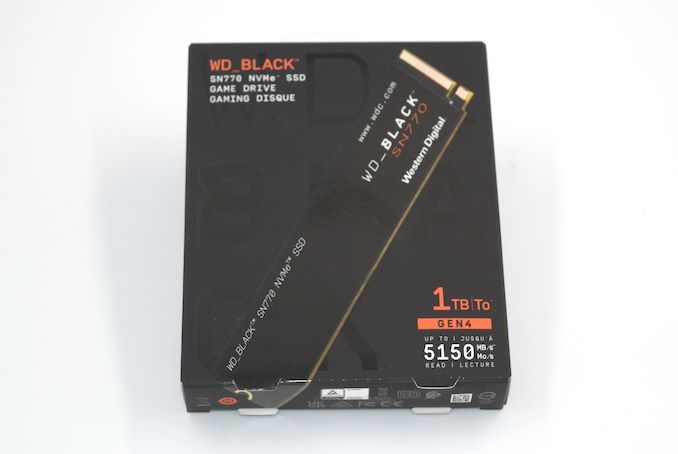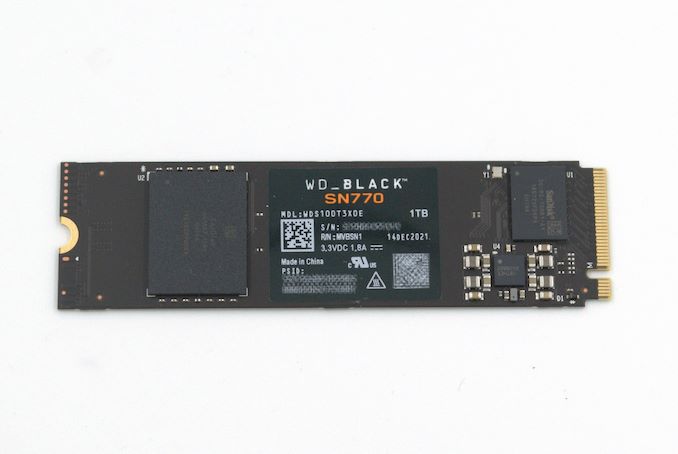Western Digital Introduces WD_BLACK SN770: A DRAM-less PCIe 4.0 M.2 NVMe SSD
by Ganesh T S on February 2, 2022 12:00 PM EST
The initial wave of PCIe 4.0 NVMe SSDs put emphasis on raw benchmark numbers, with power consumption remaining an afterthought. The targeting of high-end desktop platforms ensured that it was not much of a concern. However, with the rise of notebook and mini-PC platforms supporting PCIe 4.0, power consumption and thermal performance became important aspects. With the gaming segment tending to be the most obvious beneficiary of PCIe 4.0 in the consumer market, speeds could also not be sacrificed much in this pursuit.
DRAM-less SSDs tend to be more power-efficient and also cost less, while delivering slightly worse performance numbers and consistency in general. There are multiple DRAM-less SSD controllers in the market such as the Phison E19T (used in the WD_BLACK SN750 SE and likely, the Micron 2450 series as well), Silicon Motion SM2267XT (used in the ADATA XPG GAMMIX S50 Lite), and the Innogrit IG5220 (used in the ADATA XPG ATOM 50). While performance tends to vary a bit with the NAND being used, the drives based on the Phison E19T and the Silicon Motion SM2267XT tend to top out around 3.9 GBps, while the Innogrit IG5220 reaches around 5 GBps.
Western Digital is throwing its hat into this ring today with the launch of the WD_BLACK SN770, powered by its own in-house DRAM-less SSD controller - the SanDisk 20-82-10081. It is wresting the performance crown in this segment with read speeds of up to 5150 MBps. A 20% improvement in power efficiency over the WD_BLACK SN750 SE is also being claimed by the company. The WD_BLACK SN770 will be available in four capacities ranging from 250GB to 2TB, with the complete specifications summarized in the table below.
| Western Digital WD_BLACK SN770 SSD Specifications | ||||
| Capacity | 250 GB | 500 GB | 1 TB | 2 TB |
| Model | WDS250G3X0E | WDS500G3X0E | WDS100T3X0E | WDS200T3X0E |
| Controller | SanDisk 20-82-10081 | |||
| NAND Flash | BiCS 5 112L 3D TLC NAND? | |||
| Form-Factor, Interface | Single-Sided M.2-2280, PCIe 4.0 x4, NVMe 1.4 | |||
| DRAM | N/A | |||
| Sequential Read | 4000 MB/s | 5000 MB/s | 5150 MB/s | |
| Sequential Write | 2000 MB/s | 4000 MB/s | 4900 MB/s | 4850 MB/s |
| Random Read IOPS | 240K | 460K | 740K | 650K |
| Random Write IOPS | 470K | 800K | ||
| Avg. Power Consumption | ? W | ? W | ? W | ? W |
| Max. Power Consumption | ? W (R) ? W (W) |
? W (R) ? W (W) |
? W (R) ? W (W) |
? W (R) ? W (W) |
| SLC Caching | Yes | |||
| TCG Opal Encryption | No | |||
| MTTF | 1.75M Hours | |||
| Warranty | 5 years | |||
| Write Endurance | 200 TBW 0.44 DWPD |
300 TBW 0.33 DWPD |
600 TBW 0.33 DWPD |
1200 TBW 0.33 DWPD |
| MSRP | $59 (23.6¢/GB) | $79 (15.8¢/GB) | $129 (12.9¢/GB) | $269 (13.45¢/GB) |
The 1TB SKU appears to hit the sweet spot in terms of overall cost-efficiency as well as performance numbers. With the drive being part of the WD_BLACK lineup, the SSD is compatible with the WD_BLACK dashboard and its optional gaming mode (that turns off the low-power states to ensure the drive is operating in peak performance mode always). Thanks to the new controller, Western Digital's own test results point to the SN770 outperforming the SN750 SE even with thermal throttling in the picture, with both drives tending to cool down on the performance front beyond 55C. The higher sequential read numbers help the SN770 to lower game loading times by as much as 40% compared to the SN750 SE - claims that we are hoping to put to test in the near future.
Overall, the pricing and the Western Digital brand name should contribute to the SN770 emerging as a compelling choice in the entry-level PCIe 4.0 NVMe SSD market. Despite the WD_BLACK branding, we believe the SSD has the key features to make it suitable even for notebook platforms which do not have gaming as the primary use-case.











31 Comments
View All Comments
chrysrobyn - Thursday, February 3, 2022 - link
GPU benchmarks are boring these days because consumers can't get their hands on them. SSD benchmarks? That's where we can enjoy Anandtech. A product announcement without numbers from The Destroyer is more boring than a GPU benchmark.lightningz71 - Thursday, February 3, 2022 - link
Part of the problem with the DRAMless PCIe 3.0 NVME drives was the limited throughput of the x4 3.0 link. The doubling of bandwidth with 4.0, coupled with generally faster DRAM, even DDR5, means that, often, a dramless PCIe 4.0 x4 drive will have more bandwidth to what it uses as a DRAM cache than older drives that had integrated DRAM.lmcd - Thursday, February 3, 2022 - link
The problem wasn't DRAM speed or PCIe bandwidth, it was almost entirely latency. That's improved in part because most DRAMless controllers are also underpowered and don't have enough caches. Chances are, this WD controller has a surprising mix of more powerful/higher clocked cores than typical for a DRAMless controller and more on-die cache.Pneumothorax - Friday, February 4, 2022 - link
Assuming this will work great on PS5?twotwotwo - Friday, February 4, 2022 - link
This looks pretty neat, especially at the 1TB price and perf. On the other hand, the drive below this, the SN750 SE, has price and perf both more like their Blue drives.Practically speaking, I guess they decided gamer-y branding and a PCIe 4 interface (even at PCIe 3 speeds!) will sell them a few more drives at the lower end too. (And lower-end NVMe SSDs are good enough to rarely be the bottleneck for a lot of users.) Just odd, to me and I'm guessing the type of folks reading AT generally, that the branding isn't really related to the performance.
twotwotwo - Friday, February 4, 2022 - link
That wasn't supposed to be a reply 🤣skavi - Friday, February 4, 2022 - link
Does PS5 do host buffer?jordanclock - Saturday, February 5, 2022 - link
The PS5 does not do HMB, so this drive is probably not a great choice for that.meacupla - Sunday, February 6, 2022 - link
I think I heard from WD's twitch stream that PS5 does not currently work with SN7703ogdy - Saturday, February 5, 2022 - link
Alright, but wasn't the Black branding a synonym for High Performance from WD?They have Blue, Red, Gold, Green, Purple... yet they chose Black for a DRAM-less SSD.
I must be missing something.